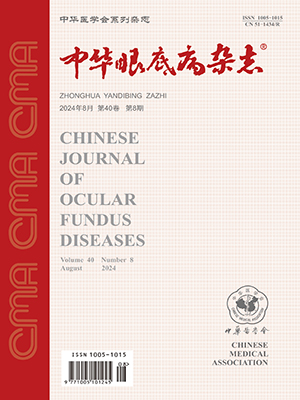| 1. |
Fierson WM, American Academy of Pediatrics Section on Ophthalmology, American Academy of Ophthalmology, et al. Screening examination of premature infants for retinopathy of prematurity[J]. Pediatrics, 2013, 131(1): 189-195. DOI: 10.1542/peds.2012-2996.
|
| 2. |
Zhou Y, Jiang Y, Bai Y, et al. Vascular endothelial growth factor plasma levels before and after treatment of retinopathy of prematurity with ranibizumab[J]. Graefe’s Arch Clin Exp Ophthalmol, 2016, 254(1): 31-36. DOI: 10.1007/s00417-015-2996-0.
|
| 3. |
Wu WC, Shih CP, Lien R, et al. Serum vascular endothelial growth factor after bevacizumab or ranibizumab treatment for retinopathy of prematurity[J]. Retina, 2017, 37(4): 694-701. DOI: 10.1097/IAE.0000000000001209.
|
| 4. |
Jin E, Bai Y, Luo L, et al. Serum levels of vascular endothelial growth factor before and after intravitreal injection of ranibizumab or conbercept for neovascular age-related macular degeneration[J]. Retina, 2017, 37(5): 971-977. DOI: 10.1097/IAE.0000000000001274.
|
| 5. |
Early Treatment for Retinopathy of Prematurity Cooperative Group. Revised indications for the treatment of retinopathy of prematurity: results of the early treatment for retinopathy of prematurity randomized trial[J]. Arch Ophthalmol, 2003, 121(12): 1684-1696. DOI: 10.1001/archopht.121.12.1684.
|
| 6. |
Feng J, Qian J, Jiang Y, et al. Efficacy of primary intravitreal ranibizumab for treatment of retinopathy of prematurity in China[J]. Ophthalmology, 2017, 124(3): 408-409. DOI: 10.1016/j.ophtha.2016.10.032.
|
| 7. |
Huang Q, Zhang Q, Fei P, et al. Ranibizumab injection as primary treatment in patients with retinopathy of prematurity: anatomic outcomes and influencing factors[J]. Ophthalmology, 2017, 124(8): 1156-1164. DOI: 10.1016/j.ophtha.2017.03.018.
|
| 8. |
程湧, 梁建宏, 黎晓新. 康柏西普玻璃体腔注射治疗急进性后极部早产儿视网膜病变的疗效观察[J]. 中华眼底病杂志, 2017, 33(2): 144-147. DOI: 10.3760/cma.j.issn.1005-1015.2017.02.008.
|
| 9. |
Jin E, Yin H, Li X, et al. Short-term outcomes after intravitreal injections of conbbercept versus ranibizumab for the treatment of retinapathy of prematurity[J]. Retina, 2018, 38(8): 1595-1604. DOI: 10.1097/IAE.0000000000001763.8:1.
|
| 10. |
Wu WC, Kuo HK, Yeh PT, et al. An updated study of the use of bevacizumab in the treatment of patients with prethreshold retinopathy of prematurity in Taiwan[J]. Am J Ophthalmol, 2013, 155: 150-158. DOI: 10.1016/j.ajo.2012.06.010.
|
| 11. |
Mintz-Hittner HA, Kennedy KA, Chuang AZ, et al. Efficacy of intravitreal bevacizumab for stage 3+ retinopathy of prematurity[J]. N Engl J Med, 2011, 364(7): 603-615. DOI: 10.1056/NEJMoa1007374.
|
| 12. |
Krohne TU, Liu Z, Holz FG, et al. Intraocular pharmacokinetics of ranibizumab following a single intravitreal injection in humans[J]. Am J Ophthalmol, 2012, 154(4): 682-686. DOI: 10.1016/j.ajo.2012.03.047.
|
| 13. |
Wong RK, Hubschman S, Tsui I. Reactivation of retinopathy of prematurity after ranibizumab treatment[J]. Retina, 2015, 35(4): 675-680. DOI: 10.1097/IAE.0000000000000578.
|
| 14. |
Kychenthal A, Dorta P. Vitrectomy after intravitreal bevacizumab (Avastin) for retinal detachmentin retinopathy of prematurity[J]. Retina, 2010, 30(4 Suppl): S32-36. DOI: 10.1097/IAE.0b013e3181ca146b.
|
| 15. |
Harper CA 3rd, Wright LM, Young RC, et al. Fluorescein angiographic evaluation of peripheral retinal vasculature after primary intravitreal ranibizumab for retinapathy of prematurity[J/OL]. Retina, 2018, 2018: E1[2018-01-03]. http://dx.doi.org/10.1097/IAE.0000000000001996. DOI: 10.1097/IAE.0000000000001996. [published online ahead of print].
|
| 16. |
Lepore D, Quinn GE, Molle F, et al. Intravitreal bevacizumab versus laser treatment in type 1 retinopathy of prematurity: report on fluorescein angiographic findings[J]. Ophthalmology, 2014, 121(11): 2212-2219. DOI: 10.1016/j.ophtha.2014.05.015.
|
| 17. |
Martinez-Castellanos MA, Velez-Montoya R, Price K, et al. Vascular changes on fluorescein angiography of premature infants with low risk of retinopathy of prematurity after high oxygen exposure[J/OL]. Int J Retina Vitreous, 2017, 3: 2[2017-01-16]. https://journalretinavitreous.biomedcentral.com/articles/10.1186/s40942-016-0055-6. DOI: 10.1186/s40942-016-0055-6.
|
| 18. |
Castellanos MA, Schwartz S, García-Aguirre G, et al. Short-term outcome after intravitreal ranibizumab injections for the treatment of retinopathy of prematurity[J]. Br J Ophthalmol, 2013, 97(7): 816-819. DOI: 10.1136/bjophthalmol-2012-302276.
|
| 19. |
Matsuyama K, Ogata N, Matsuoka M, et al. Effects of intravitreally injected bevacizumab on vascular endothelial growth factor in fellow eyes[J]. J Ocul Pharmacol Ther, 2011, 27(4): 379-383. DOI: 10.1089/jop.2010.0194.
|




